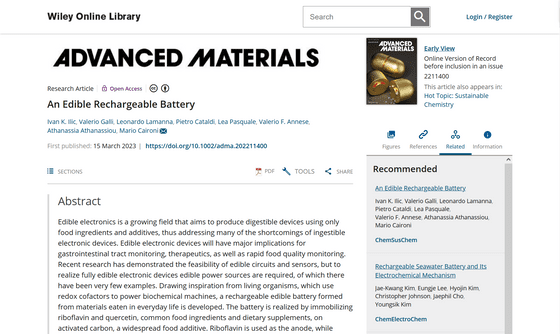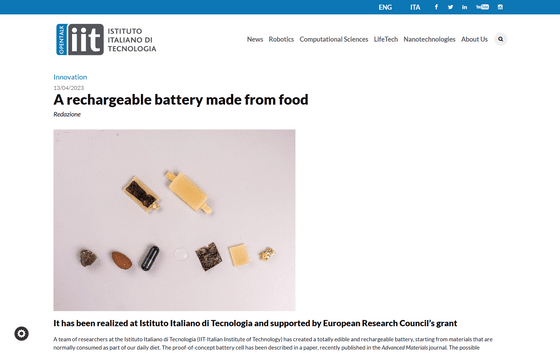New edible battery

With the advancement of technology,
An Edible Rechargeable Battery - Ilic - Advanced Materials - Wiley Online Library
https://doi.org/10.1002/adma.202211400

A rechargeable battery made from food - iiTalk

Scientists Create A Fully Rechargeable Battery, Made Entirely From Food : ScienceAlert
The battery developed by Mr. Mario Caironi et al. of the Italian Institute of Technology looks like this. All the parts that make up the battery are made of edible substances, and vitamin B2 (riboflavin) is used for the negative electrode, and quercetin, which is contained in onions and the like, is used for the positive electrode. All other parts are also made of edible materials. Sodium hydrogen sulfate is used for the electrolyte that generates electric charges, seaweed is used as a separator to prevent short circuits, and ethyl cellulose , a food additive, is laminated with gold as a current collector. We are all covered with beeswax. In addition, there is no description about the taste.

The prototype produced by Mr. Kaironi and others operated at 0.65 V and succeeded in supplying a current of 48 mA for 12 minutes. This was so weak that it did not affect the human body. Also, this battery can be charged repeatedly, and although it is necessary to charge outside the body, it is possible to maintain a sufficient state of charge even if charging and discharging are repeated dozens of times.
Mr. Kaironi said, ``In the future, it is conceivable that edible materials can be used for a wide range of applications, such as circuits, sensors that monitor health conditions, and power sources for sensors that monitor food storage conditions.In addition, this battery is safe. Considering its high toxicity, it may also be used for children's toys, which have a high risk of accidental ingestion.'

Kaironi also plans to increase the capacity and size of the edible battery, and plans to test it as a power source for the robot in the future.
'Even though this edible battery won't be installed in an electric vehicle, it will be made from materials that are safer than existing lithium-ion batteries,' said Ivan Illich of the Italian Institute of Technology, one of the study's co-authors. We believe this research will inspire other scientists to create safer batteries for a truly sustainable future.' rice field.
Related Posts:







